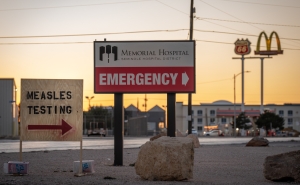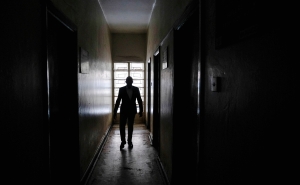Monitoring the Monkeypox Response
With monkeypox case counts rising, metrics could tell us if the epidemiological picture is pointing in the right direction.

Eliminating the spread of monkeypox will require knowing case counts, testing capacity, and contact tracing efficiency to see if we are effectively breaking chains of transmission.
Metrics and targets like these can guide our progress and identify areas of weakness in our response so that we can bolster them.
In this Q&A, adapted from the August 15 episode of the Public Health On Call podcast, Joshua Sharfstein, MD, talks with Caitlin Rivers, PhD, MPH, senior scholar at the Johns Hopkins Center for Health Security about what metrics should be considered to understand the scope of the monkeypox outbreak and the efficacy of the response.
Public Health On Call
This Q& A adapted from the August 15 episode of Public Health On Call Podcast.
What should we be focusing on in the monkeypox response?
I think our goal needs to continue to be containment, which to me means eliminating domestic transmission in the U.S. But that's a tall order because [we’ve crossed] the 10,000 case mark, which is a long way to go to zero cases. In order to get there, we need a series of metrics and targets by which we will guide our progress and identify areas of weakness in our response so that we can bolster them.
During COVID, we were learning ways to measure the growth of an infectious disease. Do they apply here too?
They do, and certainly case counts are available for monkeypox so we can look at the trends over time.
What we really want to know is whether the whole epidemiological picture is pointing in the right direction. It can't just be case counts. We also need to know how well testing and contact tracing are working, and whether we are effectively breaking chains of transmission.
That's why I think we need a small set of simple metrics to accompany case counts, to help us understand where we're going and ensure that we get there.
How often should case counts be reported?
Right now, the CDC updates case counts every weekday, and we've been averaging around 400 new cases per day. Those data come from jurisdictions—state and local public health departments—and many of those also provide their own updates. I think that's working well. Daily case counts are readily available and it's easy to see trends.
Do you feel confident that most people who need tests can get them?
No. Our testing capacity throughout the country is about 80,000 per week, which I believe to be sufficient, but we're only using about 10% of that capacity.
Test positivity has been hovering in the 40% to 60% range, and it needs to be much lower. That suggests to me that there are problems with people recognizing that they may be at risk of monkeypox, accessing a doctor, and that doctor being able to send for diagnostic testing if they suspect the virus.
In addition to the positive case counts, would you recommend tracking the percentage of all the tests taken that are positive?
Yes. The number of tests run positive and negative and from that, you can easily get test positivity.
Is interpreting test positivity more difficult for monkeypox than it was for COVID?
It is different interpreting test positivity for monkeypox than it was for COVID. It could be that clinicians are so good at recognizing monkeypox that they don't even need to swab other lesions, and so the test positivity is very high.
I suspect that's not the case, because this is a new disease for patients. It's a new disease for clinicians and the presentation is different from what has historically been reported in the academic literature. It's not the large boils that were common in textbook photographs. Many people are reporting a single lesion or just a few lesions, that may be flat or have an alternative presentation than what clinicians may have learned in school.
Since the test positivity is very high, do you think that we need a test that can catch it earlier?
That's an interesting question. It's not clear whether the illness is diagnoseable in the period before the rash develops, and it's also not clear if people are infectious during that period. Those are really important areas of research.
Right now, the test is taken by swabbing a lesion—you have to wait for the lesions to appear in order to enter the diagnostic testing pipeline. Alternative modalities like saliva, for example, should be investigated to see whether there are other ways to identify cases.
What other measures should we be focused on in the epidemic response?
A measure that was really important during the 2014 Ebola outbreak in West Africa was the proportion of cases arising from known contacts. Ideally, every new case would be diagnosed only in someone who was already in quarantine because they knew they had had an exposure.
The benefit of this is twofold: One, it means that the person who goes on to develop infection didn't have an opportunity to pass the virus on, because they knew they were at risk and they were in quarantine. Second, it means that epidemiologists have found all of the chains of transmission and are actively breaking them. Right now we really only have one data point from the UK on the proportion of cases arising from known contacts—8%—a lot of room for improvement there.
Does that show that this is an infection spreading well beyond the efforts to stop it?
That's right. Colleagues from the UK have also reported that contact tracing has been difficult for this outbreak, because many cases are unwilling or unable to elicit their contacts. That is a challenge. But even if we're not able to reach 100%, which is a high goal, if we could get to 50% or 80%, that would mean we're going a long way towards breaking those chains of transmission.
Can you talk about the time to isolation metric mentioned in your latest Substack post?
We want people who suspect or are confirmed to have infection to stay at home and avoid close contact with others. The shorter the time from rash onset to isolation, the less opportunity there is for the virus to spread. According to the CDC, it's about six to seven days. If it were approximately two days, we could be more confident that we're slowing down the virus and preventing it from reaching new people.
Is this related to the question of cases arising from contacts? It seems that if people are worried about getting it, they would self diagnose faster and stay isolated.
All these metrics work together and contextualize one another to give us a sense of what is happening with the outbreak and how we are doing in our response.
How well are we measuring monkeypox?
There's a lot of room to grow. The CDC just published their first technical report for the outbreak, which really goes into epidemiological detail about the data they're seeing, and that was really helpful. Continuing to publish updates to the technical report and to find new ways to contextualize what's happening with data is important. The piece that's really missing though, is the metrics and targets—how we know we are making progress towards containment.
At what levels would you like to see those basic metrics?
Public health officials at the federal level could help to propose and set those metrics and track them at the national level. But it's really state and local health officials who have the authority to collect the data and the responsibility to drive the local response. It does need to be an integrated response across all the levels of our public health system.
Is it going to be hard to know our progress if we don't have that?
My concern is that the outbreak will come under some kind of control and start to slow down as we're seeing in Europe, and then we'll lose focus. Getting to a low level of transmission is not good enough. We need to be aiming for zero and that is a very tall order. In order to achieve it, we need to have a systematized approach.
Is this a good example of the underlying point that we're only as strong as our fundamental public health infrastructure?
Absolutely. It's not just monkeypox. It's also COVID, which was enormously taxing for our public health system. There are now concerns about a resurgence of polio, which has been eliminated in the U.S. for decades. We're really seeing the way that our public health system can become brittle and threats that we're not accustomed to thinking about because they have so long been under control begin to break through.
Joshua Sharfstein, MD, is the vice dean for Public Health Practice and Community Engagement and a professor in Health Policy and Management at the Johns Hopkins Bloomberg School of Public Health. He is also the director of the Bloomberg American Health Initiative and a host of the Public Health On Call podcast.





